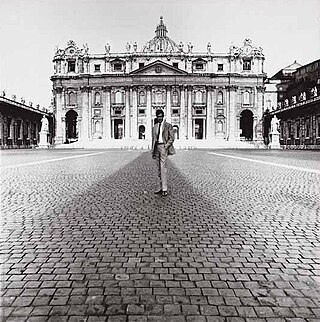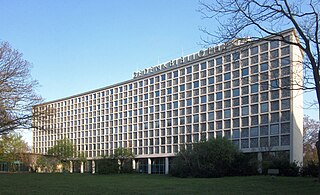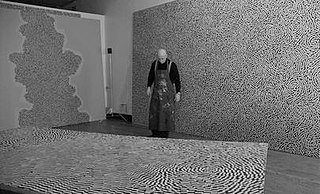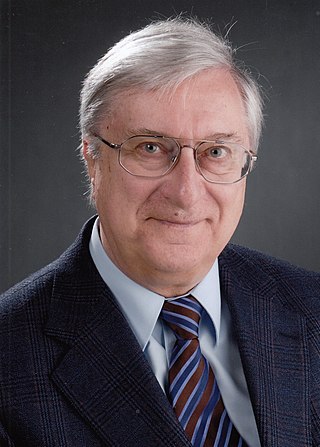
Peter Weibel was an Austrian post-conceptual artist, curator, and new media theoretician. He started out in 1964 as a visual poet, then later moved from the page to the screen within the sense of post-structuralist methodology. His work includes virtual reality and other digital art forms. From 1999 he was the director of the ZKM Center for Art and Media Karlsruhe.

The ZKM | Center for Art and Media Karlsruhe, a cultural institution, was founded in 1989 and, since 1997, is located in a former munitions factory in Karlsruhe, Germany. The ZKM organizes special exhibitions and thematic events, conducts research and produces works on the effects of media, digitization, and globalization, and offers public as well as individualized communications and educational programs.

The Kunstakademie Düsseldorf is the academy of fine arts of the state of North Rhine Westphalia at the city of Düsseldorf, Germany. Notable artists who studied or taught at the academy include Joseph Beuys, Gerhard Richter, Magdalena Jetelová, Gotthard Graubner, Nam June Paik, Nan Hoover, Katharina Fritsch, Tony Cragg, Ruth Rogers-Altmann, Sigmar Polke, Anselm Kiefer, Rosemarie Trockel, Thomas Schütte, Katharina Grosse and photographers Thomas Ruff, Thomas Demand, Thomas Struth, Andreas Gursky and Candida Höfer. In the stairway of its main entrance are engraved the Words: "Für unsere Studenten nur das Beste".

Lothar Wolleh was a well-known German photographer.
StudiVZ, SchülerVZ and MeinVZ was a social networking platform for students and based in Berlin, Germany. The name is an abbreviation of the German expression Studentenverzeichnis, which means students' directory.

Fritz Bornemann was a German architect.
Charles Paul Wilp was a German advertising-designer, artist, photographer and short-movie-editor.
Von hier aus – Zwei Monate neue deutsche Kunst in Düsseldorf is the title of an art exhibition from 29 September 1984 to 2 December 1984. It was organised by the city of Düsseldorf and the Gesellschaft für aktuelle Kunst Düsseldorf e.V. and was curated by Kasper König.

Gary Mark Smith is an American street photographer. Smith is noted for his pioneering global range and his empathetic and literal style of photography sometimes captured in extremely hazardous circumstances.
Tom Corby and Gavin Baily (1970) are two London based artists who work collaboratively using public domain data, climate models, satellite imagery and the Internet. Recent work has focused on climate change and its relationship to technology and has involved collaborations with scientists working at the British Antarctic Survey.
Stephen I, Count of Sponheim is the patriarch of the Rhenish branch of the House of Sponheim, which ruled over the County of Sponheim. He was closely related to Siegfried I, Count of Sponheim, patriarch of the Carinthian Sponheimish branch, but the exact relationship between the two dynasts is disputed. Johannes Trithemius credits a Count Eberhard of Sponheim as founder of the Abbey of Sponheim and dates the founding to 1044, a position questioned by Johannes Mötsch. The Genealogia Sponhemica presents Count Eberhardus as son of Countess Hedwig and father of a single Count Stephenus I/II of Sponheim. Donald C. Jackman considers Stephen I a son of Siegfried I. Both Jackman and Josef Heinzelmann consider Stephen as being identical to Stephen, Vogt of Worms documented with his brother Markward in 1068. Heinzelmann however casts doubt on a male lineage relationship of Stephen and Siegfried and sees Stephen I of Sponheim as being Lord of Sponheim but not a Count, notices that Stephen I of Sponheim is documented in 1075 as "S(igna) Stepheni de Spanheim" with his seal in a document of Udo, Archbishop of Trier, and proposes Stephen to have married into the House of Sponheim. In another work Heinzelmann considers the Stephen mentioned in 1075 to be Stephen II, or maybe a single Stephen, mentions a Mainzer ministerialis Stephen, the son of Embricho (Emich) and nephew of Archbishop Ruthard, who lived later, as a possible relation, and puts forward that the documented Stephen and Markward belong to the House of the Counts of Metz/Lunéville, which later provided the Vogts of Worms:
"Identisch kann er sein mit einem Wormser Vogt Stephen (1068) [239 UB Stadt Worms I, Nr. 55], der mit seinem Bruder Markwart zu den Grafen von Lunéville/Metz zu gehören scheint, die mit den de Meti später die Wormser Vögte stellen."
Elmar Hess is a German artist.

Antje (-Maria) von Graevenitz, born Ludwig is a German art historian, art critic, educator and author.

Sep Ruf was a German architect and designer strongly associated with the Bauhaus group. He was one of the representatives of modern architecture in Germany after World War II. His elegant buildings received high credits in Germany and Europe and his German pavilion of the Expo 58 in Brussels, built together with Egon Eiermann, achieved worldwide recognition. He attended the Interbau 1957 in Berlin-Hansaviertel and was one of the three architects who had the top secret order to create the governmental buildings in the new capital city of the Federal Republic of Germany, Bonn. His best known building was the residence for the Federal Chancellor of the Federal Republic of Germany, built for Ludwig Erhard, the so-called Chancellor's Bungalow.

Luca Lazar or Luka Lasareishvili is a Georgian artist. He was born on 14 November 1957 in Tbilisi, Georgia. He studied at the Tbilisi State Art Academy from 1976 to 1982 from which he graduated with a Masters of Fine Arts degree. Since 1982 he has been working as an independent, professional artist and participated in numerous solo- and group exhibitions in galleries and museums. He has worked in a variety of media: painting, installations, object and video art. From 1985 until 1988 Lazar lived and worked in Moscow, Russia. He then moved on to Paris, France. The following year, 1989, Lazar spent in Kassel, Germany as an artist-in-residence with the Museum Fridericianum. From 1990 until 2003 Lazar lived and worked in Cologne, Germany. During his time in Germany, sweeping changes were taking place in his native region that led to the collapse of the Soviet Union, the declaration of independence of Georgia and was followed by armed conflicts and civil war in his country of origin. As Lazar was unable to return, he stayed on in Germany, where he eventually received citizenship. From 1997 until 2005 he held a position as lecturer at the European Academy of Fine Arts in Trier, Germany. In 2003 Lazar relocated to New York City, United States, where he has continued his artistic career.
Iman Rezai is an artist currently living and working in Berlin, Germany.
Sabine Funke is a German painter who lives and works since 1987 in Karlsruhe.
Jiny Lan is a German-based Chinese visual artist from Xiuyan, Liaoning Province, in the People’s Republic of China. Before emigrating to Germany in 1995, she graduated from the China Academy of Fine Arts, in Hangzhou. Lan is one of the founding members of the “Bald Girls”, the first feminist art collective founded in China, which seeks to promote Chinese avant-garde feminist art internationally while similarly introducing internationally influential feminist artists to China. Her work primarily consists of paintings, performances, installations, multi-media forms, and films.
The Große Deutsche Kunstausstellung was held a total of eight times from 1937 to 1944 in the purpose-built Haus der Deutschen Kunst in Munich. It was representative of art under Nazism.

Hermann Josef Ludwig Roth is a German theologian and scientist, cultural historian and historian of science, educator and monument preservation and nature conservation activist. He is a specialist in the area of mediaeval reform movements and is considered today’s foremost expert on the geography of the Rhineland region and on the life and work of the naturalist, Prince Maximilian of Wied-Neuwied, and his circle.










